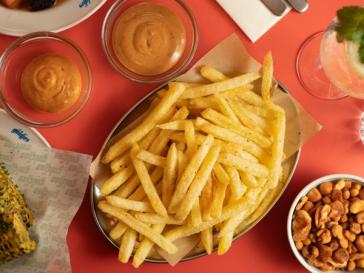

Words: Matt Roberts
This week I’m shifting things back to the upper body to focus on the shoulders, also known as the deltoids or delts for short. The delts are partitioned into three distinct heads; the anterior head at the front, the medial head in the middle and the posterior head at the back. The way you move the shoulder will affect which head contributes most to the exercise so I’ll provide a choice for each one to help maximize growth and symmetry.
For most recreational exercises this should be your go to option when it comes to pressing overhead. Not only does it offer a good hit on the delts (mostly anterior), it also offers lots of other great benefits. Firstly, the angle of the press helps to limit any compensatory movements commonly seen in other areas of the body during overhead pressing, such as excessive arching of the lower back and rib flare (people often lack the true range of motion to go straight overhead without compensation).
Secondly, as the angle of the press improves the ability to resist lower back extension, it serves as a great abdominal exercise. Thirdly, using one arm at a time helps to even out any left to right strength differences, while simultaneously improving thoracic mobility (an area of the body where most people need more mobility) and dynamic stability of the shoulder blades (a key attribute for good shoulder health).
Probably everyone’s all-time favourite choice for hitting the medial delts, this is an exercise many people are likely to have included in their programs before. However, it’s important to ensure you’re doing it right to really stimulate the middle portion of the shoulder. When done correctly, this is an exercise that doesn’t call for big weights, so check the ego a little and go a bit lighter than you might think.
Start with the dumbbells in each hand resting by your sides. Lift the arms out to the sides so that elbows come level with shoulder height and are positioned slightly in front of the body (the hands don’t need to go above the height of the elbow, and the elbow can be slightly bent). As you do the movement, to really hit the medial delts you need to add a little internal shoulder rotation by ensuring the front of the hand is tilted slightly towards the ground.
Like the lateral raises, this is one of the more popular shoulder exercises for the posterior delts. It’s also similar in that when done correctly the weights don’t need to be heavy as to really stimulate the back of the shoulder the quality of the movement should take priority.
There are a couple of options when it comes to the set up with this exercise but when muscle growth is the priority I prefer to straddle and lye prone (chest down) on an incline bench. This is because it reduces the stability demands that a free standing bent over position might require and allows for more effort to go into hitting the delts.
Once in position on the bench, hold dumbbells in each hand and let the arms hang either side. Lift the arms out to the sides with elbows slightly bent and feel the shoulder blades move around the ribcage until they meet in the middle (use this to guide the range of motion rather than trying to get the arms as far back as you can). As you do the movement, to maximally stimulate the posterior delts you need to add some shoulder external rotation by ensuring the palms are turned up slightly.
All three of these exercises will work well with the set and rep scheme from previous weeks:
Week 1 – 3×8 (72reps/session, 144reps/week), Week 2 – 3x 10 (90reps/session, 180reps/week), Week 3 – 3×12 (108reps/session, 216reps/week), Week 4 (deload week), 2×10 (60reps/session, 120reps/week). Then repeat the cycle for next 4 weeks aiming to add small increases to the weights used (don’t miss any reps though!). Aim to include these exercises into your training schedule twice each week.
The best post workout nutrition strategies often depend on how much and when you ate prior to training. If your pre-training meal was a small one or you ate it several hours before training, then it’s probably more important for you to get that post-workout meal into your system quite quickly. Ideally within an hour.
If you trained in a fasted state (say, first thing in the morning before breakfast) then it’s also a good idea to eat a balanced meal as soon after your workout as you can. But if you ate a normal sized mixed meal a couple of hours before training (or a small shake closer to training), then you have a full one to two hours after training to eat your post-workout meal and still maximize the benefits of workout nutrition.
– Matt Roberts is a UK-leading personal trainer and best-selling fitness author. Learn more here.


